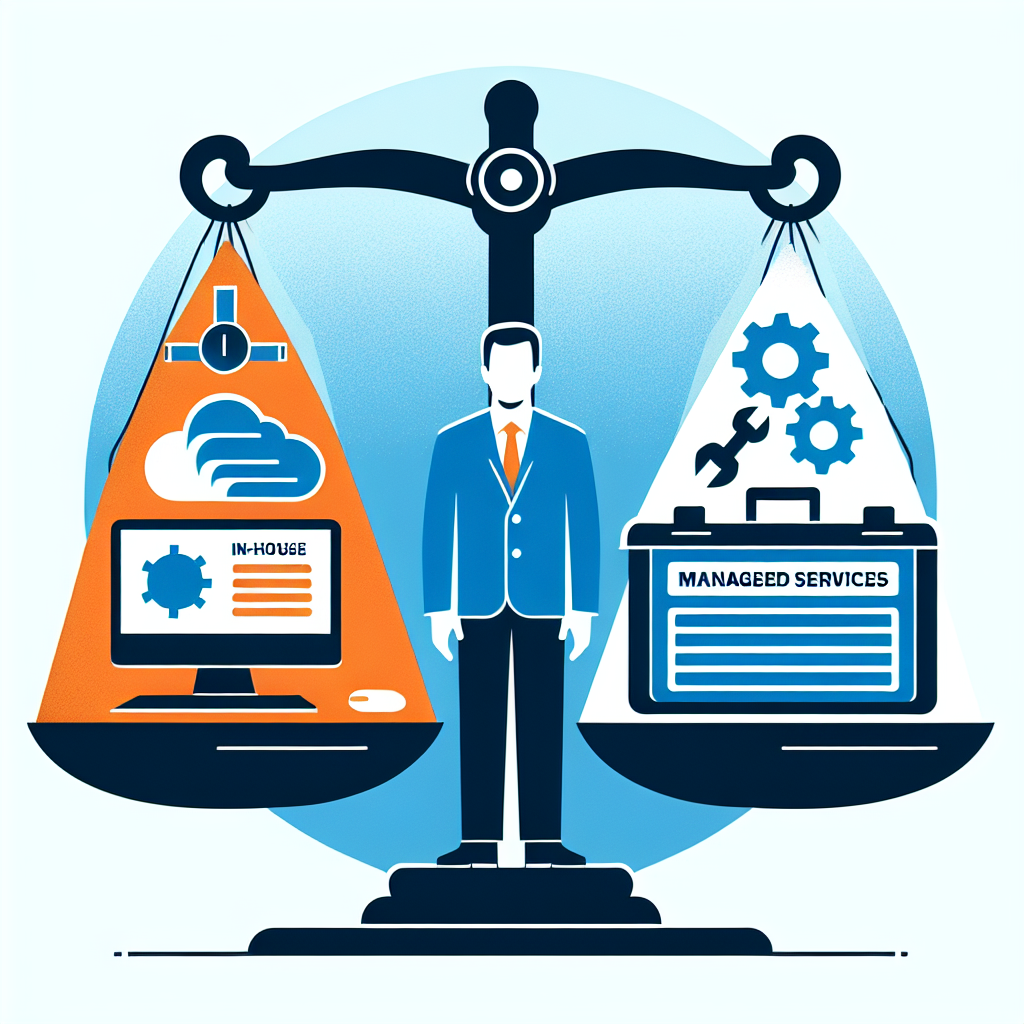Your cart is currently empty!
Tag: inhouse

Outsourcing IT: Finding the Right Balance Between In-House and External Support
Outsourcing IT: Finding the Right Balance Between In-House and External SupportIn today’s fast-paced business environment, companies are constantly looking for ways to streamline their operations and cut costs. One way many businesses are achieving this is by outsourcing their IT support. Outsourcing IT can provide a number of benefits, including cost savings, access to specialized expertise, and increased flexibility. However, finding the right balance between in-house and external support is crucial to ensure that your IT needs are being met effectively and efficiently.
One of the key advantages of outsourcing IT support is cost savings. By outsourcing IT services, companies can reduce overhead costs associated with hiring and maintaining an in-house IT department. External IT providers often offer pricing models that are more flexible and cost-effective than hiring full-time employees. This can result in significant savings for companies, particularly smaller businesses with limited budgets.
Another benefit of outsourcing IT support is access to specialized expertise. External IT providers often have a team of experts with a wide range of skills and experience. This can be especially valuable for companies that have complex IT needs or require specialized knowledge in certain areas. By outsourcing IT services, companies can tap into this expertise without having to invest in training or hiring new employees.
In addition to cost savings and specialized expertise, outsourcing IT support can also provide companies with increased flexibility. External IT providers can scale their services up or down based on the company’s needs, allowing businesses to adapt quickly to changing requirements. This can be particularly important for businesses with fluctuating IT demands or seasonal variations in workload.
However, while outsourcing IT support can offer many benefits, it is important for companies to find the right balance between in-house and external support. While outsourcing can be cost-effective and provide access to specialized expertise, there are also drawbacks to consider. For example, companies may have less control over the quality and timeliness of service when working with external providers. In addition, outsourcing IT support can sometimes lead to communication challenges or lack of alignment with the company’s goals and priorities.
To find the right balance between in-house and external support, companies should carefully evaluate their IT needs and consider the pros and cons of outsourcing. It may be beneficial to start with a hybrid approach, where some IT services are outsourced while others are handled in-house. This can help companies leverage the benefits of outsourcing while maintaining control over critical functions.
Ultimately, the key to successful IT outsourcing is finding a partner that aligns with your company’s goals and values. Look for a provider that has a strong track record of delivering high-quality services, offers transparent pricing and contract terms, and has a commitment to ongoing communication and collaboration. By finding the right balance between in-house and external support, companies can maximize the benefits of outsourcing IT and achieve their business goals more effectively.

IT Outsourcing vs. In-House Solutions: Making the Best Choice for Your Business
In today’s fast-paced and technology-driven world, businesses are constantly looking for ways to stay competitive and efficient. One of the key decisions that companies often face is whether to outsource their IT services or keep them in-house. Both options have their pros and cons, and choosing the best solution for your business depends on a variety of factors.IT outsourcing has become increasingly popular in recent years, as it offers companies a cost-effective way to access specialized skills and expertise without the need to hire and train in-house IT staff. Outsourcing also allows businesses to scale their IT services up or down as needed, providing flexibility and cost savings. Additionally, outsourcing can free up internal resources and allow employees to focus on core business activities.
On the other hand, keeping IT services in-house offers businesses more control and visibility over their IT operations. In-house IT staff are more familiar with the company’s specific needs and can provide more personalized support. Additionally, having an in-house IT team can help ensure that sensitive data and information are kept secure and confidential.
When deciding between IT outsourcing and in-house solutions, it’s important to consider the specific needs and goals of your business. Factors to consider include the size and complexity of your IT infrastructure, your budget, and the level of control and security you require. It’s also important to evaluate the expertise and experience of potential IT outsourcing partners, as well as their track record of success.
Ultimately, the best choice for your business will depend on a variety of factors, and there is no one-size-fits-all solution. Some businesses may benefit from outsourcing certain IT services, while others may prefer to keep everything in-house. By carefully weighing the pros and cons of both options and considering your specific needs, you can make the best choice for your business and ensure that your IT operations are efficient, secure, and cost-effective.

Managed Services vs. In-House IT: Making the Right Choice
In today’s fast-paced business world, technology plays a crucial role in the success of any organization. Whether it’s managing data, maintaining network security, or troubleshooting technical issues, having a reliable IT infrastructure is essential. However, many businesses struggle with the decision of whether to outsource their IT needs to a managed services provider or keep them in-house. Both options have their own advantages and disadvantages, so it’s important to weigh the pros and cons before making a decision.Managed services providers offer a range of IT services, from network monitoring and security to data backup and disaster recovery. By outsourcing these tasks to a managed services provider, businesses can benefit from the expertise and experience of a team of IT professionals without the need to hire and train their own staff. This can result in cost savings, as businesses only pay for the services they need, rather than maintaining a full-time IT department. Managed services providers also typically offer 24/7 support, ensuring that any technical issues are resolved quickly and efficiently.
On the other hand, keeping IT services in-house can give businesses greater control over their IT infrastructure and operations. In-house IT staff are familiar with the specific needs and requirements of the organization, and can tailor their services accordingly. This can be particularly beneficial for businesses with unique or specialized IT needs. In-house IT staff can also provide a more personalized level of service, as they are dedicated solely to the needs of the organization.
When deciding between managed services and in-house IT, businesses should consider factors such as cost, expertise, and scalability. Managed services providers can offer cost-effective solutions for businesses of all sizes, while in-house IT may require a larger upfront investment in infrastructure and personnel. Businesses should also consider the level of expertise required for their IT needs – if they have complex technical requirements, a managed services provider may be the best option. Finally, businesses should consider their long-term growth and scalability needs, as managed services providers can easily scale their services to meet changing demands.
Ultimately, the decision between managed services and in-house IT will depend on the specific needs and goals of the organization. Businesses should carefully evaluate their options and consider factors such as cost, expertise, and scalability before making a decision. By making the right choice, businesses can ensure that their IT infrastructure is reliable, secure, and able to support their long-term growth and success.

Managed Services vs. In-House IT: Which Is Right for Your Business?
In today’s fast-paced and technology-driven business world, having a reliable and efficient IT infrastructure is essential for success. As businesses continue to rely on technology for their day-to-day operations, the debate between using managed services or in-house IT support has become increasingly important.Managed services, also known as outsourcing IT services to a third-party provider, have become a popular choice for many businesses. These services offer a range of benefits, including cost savings, access to specialized expertise, and round-the-clock support. With managed services, businesses can offload the responsibility of managing their IT infrastructure to a team of experienced professionals, allowing them to focus on their core business objectives.
On the other hand, some businesses prefer to keep their IT support in-house, believing that it provides greater control and flexibility over their IT systems. In-house IT teams are directly employed by the business and are typically more familiar with the organization’s specific needs and requirements. However, maintaining an in-house IT department can be costly and time-consuming, as businesses need to invest in hiring and training staff, as well as keeping up-to-date with the latest technologies.
So, which option is right for your business? The answer ultimately depends on your organization’s size, budget, and IT requirements.
For small and medium-sized businesses with limited resources, managed services may be the best choice. These businesses can benefit from the expertise and scalability of a managed services provider without the high costs associated with maintaining an in-house IT team. Managed services also offer businesses access to the latest technologies and security measures, helping them stay competitive in today’s digital landscape.
On the other hand, larger businesses with complex IT needs may find that in-house IT support is more suitable. These businesses often have the resources to invest in a dedicated IT team and can benefit from greater control over their IT systems. In-house IT teams can also provide more personalized support and tailor solutions to the organization’s specific requirements.
Ultimately, the decision between managed services and in-house IT support comes down to what works best for your business. It’s important to weigh the pros and cons of each option and consider factors such as cost, expertise, and scalability. No matter which option you choose, having a reliable IT infrastructure is crucial for the success of your business in today’s digital age.

Outsourcing vs. In-house IT: Pros and Cons
In today’s fast-paced business world, technology plays a crucial role in the success of any company. As businesses grow and evolve, the need for IT support becomes increasingly important. One of the key decisions that business owners need to make is whether to outsource their IT needs or keep them in-house. Both options have their pros and cons, and it’s essential to understand them before making a decision.Outsourcing IT services involves hiring a third-party provider to handle all aspects of your company’s technology needs, including network management, software development, and technical support. On the other hand, keeping IT services in-house means hiring a team of IT professionals to handle these tasks internally.
One of the main advantages of outsourcing IT services is cost savings. By outsourcing, companies can avoid the high costs associated with hiring and training an in-house IT team. Outsourcing also allows businesses to access a broader range of expertise and resources that they may not have in-house. This can be especially beneficial for small and medium-sized businesses that may not have the budget to hire a full-time IT staff.
Another benefit of outsourcing IT services is flexibility. Outsourcing allows companies to scale their IT services up or down as needed, depending on their business requirements. This can be particularly useful for businesses that experience seasonal fluctuations in demand or need to rapidly expand their IT infrastructure.
On the other hand, keeping IT services in-house offers some advantages as well. One of the main benefits is control. By having an in-house IT team, companies have more control over their technology infrastructure and can customize solutions to fit their specific needs. In-house IT teams are also more familiar with the company’s business processes and can provide tailored solutions that align with the company’s goals and objectives.
Additionally, having an in-house IT team can lead to quicker response times and better communication. When IT issues arise, having a team on-site can result in faster problem resolution and reduced downtime. In-house teams also have a better understanding of the company’s operations and can provide more personalized support.
However, there are also drawbacks to keeping IT services in-house. One of the main disadvantages is the high cost associated with hiring and training IT professionals. In addition, maintaining an in-house IT team can be time-consuming and distracting for business owners, as they may need to devote time and resources to managing the team.
Ultimately, the decision to outsource IT services or keep them in-house will depend on the specific needs and resources of each individual company. Small businesses with limited budgets may find outsourcing to be a more cost-effective solution, while larger companies with complex IT needs may benefit from having an in-house team.
In conclusion, both outsourcing and in-house IT services have their pros and cons. It’s essential for business owners to carefully consider their needs, budget, and long-term goals before making a decision. By weighing the advantages and disadvantages of each option, companies can make an informed choice that will best support their IT infrastructure and overall business success.

MSPs vs. In-House IT: Making the Right Choice for Your Business
In today’s technology-driven world, businesses rely heavily on IT systems to operate efficiently and effectively. With the increasing complexity of IT infrastructure and the constant need for support and maintenance, many businesses are faced with the decision of whether to manage their IT needs in-house or to outsource to a Managed Service Provider (MSP).Both options have their own set of advantages and disadvantages, and the decision ultimately depends on the unique needs and goals of each individual business. In this article, we will explore the differences between MSPs and in-house IT departments to help you make the right choice for your business.
MSPs, also known as IT service providers, are third-party companies that offer a range of IT services and solutions to businesses. These services can include network monitoring, security management, data backup and recovery, cloud computing, and more. By outsourcing their IT needs to an MSP, businesses can benefit from the expertise and resources of a team of professionals without the need to hire and manage an in-house IT department.
One of the main advantages of working with an MSP is cost savings. By outsourcing IT services, businesses can avoid the high costs associated with hiring and training IT staff, purchasing and maintaining hardware and software, and dealing with unexpected IT emergencies. MSPs typically offer flexible pricing plans that can be tailored to the specific needs and budget of each business, making it a cost-effective solution for businesses of all sizes.
Another advantage of working with an MSP is access to a team of experts with specialized knowledge and experience in a wide range of IT technologies. MSPs are constantly monitoring and managing their clients’ IT systems, which allows them to quickly identify and address issues before they become major problems. This proactive approach to IT management can help businesses avoid costly downtime and minimize the risk of security breaches.
On the other hand, some businesses may prefer to keep their IT needs in-house for a variety of reasons. One of the main advantages of an in-house IT department is greater control and customization. Businesses that have unique IT requirements or security concerns may prefer to keep their IT systems in-house to ensure that they have full control over their technology infrastructure.
In-house IT departments also offer a level of personalization and responsiveness that may be lacking with an MSP. By having IT staff on-site, businesses can receive immediate support and tailored solutions to their IT issues, without having to wait for a third-party provider to respond.
However, maintaining an in-house IT department can be costly and time-consuming. Businesses will need to invest in hiring and training IT staff, purchasing and maintaining hardware and software, and keeping up with the latest technology trends and security threats. In addition, in-house IT departments may not have the same level of expertise and resources as an MSP, which could leave businesses vulnerable to IT issues and security breaches.
Ultimately, the decision of whether to work with an MSP or keep IT services in-house will depend on the unique needs and goals of each business. Small businesses with limited resources and expertise may benefit from outsourcing their IT needs to an MSP, while larger businesses with specific requirements or security concerns may prefer to keep their IT systems in-house.
Before making a decision, businesses should carefully consider their budget, IT requirements, and long-term goals to determine the right choice for their business. By weighing the pros and cons of both options, businesses can make an informed decision that will help them achieve their IT goals and drive success in today’s competitive business landscape.

Managed Services vs. In-House IT: Making the Best Choice for Your Business
In today’s rapidly changing business landscape, technology plays a crucial role in driving growth and productivity. As a result, businesses of all sizes are increasingly relying on IT systems and infrastructure to stay competitive. However, the question of whether to opt for managed services or in-house IT support continues to be a crucial decision for many organizations.Managed services refer to the practice of outsourcing the management of IT systems and functions to a third-party provider. These providers offer a range of services, including network monitoring, data backup, cybersecurity, and helpdesk support, among others. In contrast, in-house IT involves hiring and managing a dedicated team of IT professionals to handle all technology-related tasks and issues internally.
So, how do you decide which option is best for your business? Let’s explore the benefits and drawbacks of both managed services and in-house IT support to help you make an informed decision.
Managed services offer several advantages, including cost savings, access to a team of experts, and scalability. By outsourcing IT functions to a managed services provider, businesses can reduce overhead costs associated with hiring and training IT staff. Additionally, managed services providers typically have a team of experts with specialized skills and experience, ensuring that your IT systems are well-maintained and secure. Moreover, managed services are scalable, allowing businesses to easily adjust their IT support needs as their operations grow or change.
On the other hand, in-house IT support provides businesses with greater control and customization over their IT systems. With an in-house team, businesses can tailor their IT infrastructure to meet specific requirements and business goals. In-house IT staff also have a deeper understanding of the business’s operations and can provide more personalized support. However, in-house IT support can be costly and time-consuming, as businesses must invest in hiring, training, and retaining skilled IT professionals.
Ultimately, the decision between managed services and in-house IT support will depend on the unique needs and objectives of your business. Consider factors such as your budget, technological requirements, and long-term goals when evaluating your options. Some businesses may find that a combination of both managed services and in-house IT support is the best solution, allowing them to leverage the benefits of both approaches.
In conclusion, choosing between managed services and in-house IT support is a critical decision that can have a significant impact on your business’s success. Carefully weigh the pros and cons of each option to determine which one aligns best with your business needs. Whether you opt for managed services, in-house IT support, or a combination of both, investing in reliable and efficient IT support is essential for driving growth and staying ahead in today’s competitive market.

Managed Service Provider vs. In-House IT Department: Which is Right for Your Business?
In today’s fast-paced business world, technology plays a crucial role in the success of any organization. Whether it’s ensuring seamless communication, enhancing productivity, or safeguarding sensitive data, having a reliable IT infrastructure is essential. However, the question that many businesses face is whether to rely on a Managed Service Provider (MSP) or maintain an in-house IT department.Managed Service Providers are third-party companies that offer a range of IT services, including network monitoring, cybersecurity, data backup, and more. On the other hand, an in-house IT department consists of internal employees who are dedicated to managing and maintaining the company’s IT systems.
One of the main advantages of partnering with an MSP is cost savings. By outsourcing IT services, businesses can avoid the expenses associated with hiring and training IT staff, as well as investing in expensive hardware and software. MSPs also offer flexible pricing models, allowing businesses to scale their IT services based on their needs and budget.
Another benefit of working with an MSP is access to a team of highly skilled IT professionals. MSPs often have a diverse range of experts with specialized knowledge in various areas of IT, enabling businesses to tap into a wealth of expertise that may not be available in an in-house IT department. This can be particularly advantageous for small and medium-sized businesses that may not have the resources to hire a full team of IT professionals.
On the other hand, maintaining an in-house IT department provides businesses with greater control and customization over their IT infrastructure. Internal IT staff are familiar with the company’s operations and can tailor solutions to meet specific needs and goals. In-house IT departments also offer more immediate support and responsiveness, as employees are readily available on-site to address any issues that may arise.
However, building and maintaining an in-house IT department can be costly and time-consuming. Businesses must invest in recruiting, training, and retaining skilled IT professionals, as well as purchasing and maintaining hardware and software. Additionally, in-house IT departments may struggle to keep up with rapidly changing technology trends and cybersecurity threats, leading to potential vulnerabilities.
So, which option is right for your business? Ultimately, the decision between partnering with an MSP or maintaining an in-house IT department depends on your specific needs, budget, and goals. For businesses looking to streamline operations, reduce costs, and access a broad range of expertise, partnering with an MSP may be the ideal solution. On the other hand, if your business requires customized solutions, immediate support, and greater control over your IT infrastructure, maintaining an in-house IT department may be the better choice.
In conclusion, both Managed Service Providers and in-house IT departments have their own advantages and disadvantages. It’s essential for businesses to carefully evaluate their needs and resources before making a decision. Ultimately, the goal is to choose the option that will best support your business’s growth and success in the long run.

MSP vs In-House IT: Which is Right for Your Business?
In today’s technology-driven world, having reliable IT support is essential for businesses of all sizes. However, many companies struggle with deciding whether to outsource their IT needs to a managed service provider (MSP) or keep everything in-house. Both options have their own benefits and drawbacks, so it’s important to carefully consider which is the right choice for your business.Managed Service Providers (MSPs) are third-party companies that provide IT services to businesses on a subscription basis. They offer a wide range of services, from basic help desk support to advanced network security solutions. By outsourcing their IT needs to an MSP, businesses can take advantage of the expertise and resources of a dedicated team of professionals without the need to hire and manage in-house IT staff.
One of the main advantages of using an MSP is cost savings. By outsourcing IT services, businesses can avoid the high costs of hiring and training in-house IT staff, as well as the expenses associated with maintaining and upgrading hardware and software. Additionally, MSPs often offer flexible pricing plans that can be tailored to meet the specific needs and budget of each business.
Another benefit of using an MSP is access to a team of experts with specialized knowledge and experience. MSPs employ IT professionals who are trained and certified in various technologies, allowing them to provide high-quality support and solutions to their clients. This can be particularly valuable for small and medium-sized businesses that may not have the resources to hire a full-time IT team.
On the other hand, some businesses may prefer to keep their IT services in-house for greater control and customization. By hiring and managing their own IT staff, businesses can ensure that their IT infrastructure is tailored to meet their specific needs and objectives. In-house IT teams can also provide more personalized support and faster response times, as they are directly accountable to the company.
However, maintaining an in-house IT department can be costly and time-consuming. Businesses must invest in hiring and training IT staff, as well as purchasing and maintaining hardware and software. Additionally, in-house IT teams may not have the same level of expertise and resources as MSPs, which can limit their ability to provide advanced solutions and support.
Ultimately, the decision to use an MSP or keep IT services in-house will depend on the specific needs and resources of each business. Small and medium-sized businesses with limited budgets and IT expertise may benefit from outsourcing their IT needs to an MSP, while larger companies with more complex IT requirements may prefer to keep everything in-house.
Before making a decision, businesses should carefully evaluate their IT needs, budget, and long-term goals to determine which option is the best fit for their organization. By choosing the right IT support model, businesses can ensure that their technology infrastructure is secure, reliable, and aligned with their business objectives.

Managed Services vs. In-House IT: Making the Case for Outsourcing
In today’s fast-paced business environment, technology plays a crucial role in the success of any organization. As businesses grow and evolve, the need for efficient IT solutions becomes more apparent. However, many companies struggle with the decision of whether to manage their IT needs in-house or outsource them to a managed services provider.Managed services vs. in-house IT is a debate that has been ongoing for years. While there are benefits to both approaches, outsourcing IT services to a managed services provider can often be the better choice for businesses looking to streamline their operations and improve their overall efficiency.
One of the key advantages of outsourcing IT services to a managed services provider is cost savings. When businesses manage their IT needs in-house, they often have to invest in expensive hardware, software, and personnel to handle their IT infrastructure. On the other hand, outsourcing IT services allows businesses to pay a fixed monthly fee for a range of services, eliminating the need for costly upfront investments and reducing overall IT expenses.
Another benefit of outsourcing IT services is access to a team of experts. Managed services providers employ skilled professionals who specialize in various areas of IT, including network security, cloud computing, and data backup. By outsourcing IT services, businesses can tap into the expertise of these professionals and benefit from their knowledge and experience, without having to hire and train an in-house IT team.
Additionally, outsourcing IT services can help businesses improve their overall efficiency and productivity. Managed services providers offer round-the-clock monitoring and support, ensuring that IT issues are promptly addressed and resolved before they have a chance to disrupt business operations. This proactive approach to IT management can help businesses minimize downtime, increase employee productivity, and ultimately improve customer satisfaction.
In conclusion, while there are benefits to managing IT needs in-house, outsourcing IT services to a managed services provider can often be the more cost-effective and efficient choice for businesses. By partnering with a managed services provider, businesses can access a team of experts, reduce IT expenses, and improve overall efficiency, ultimately helping them achieve their business goals and stay ahead of the competition.
